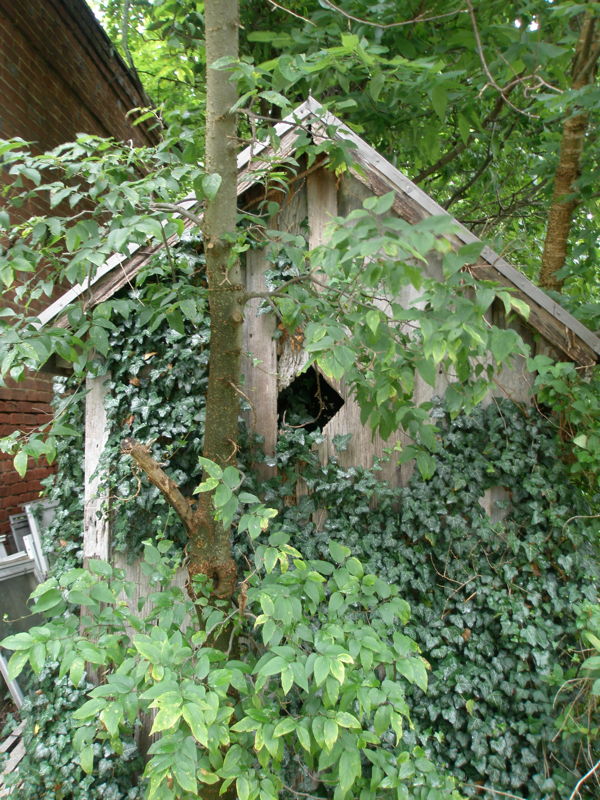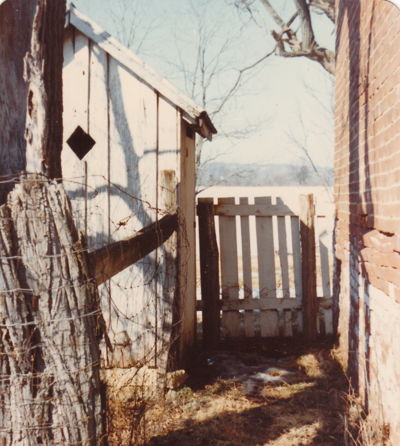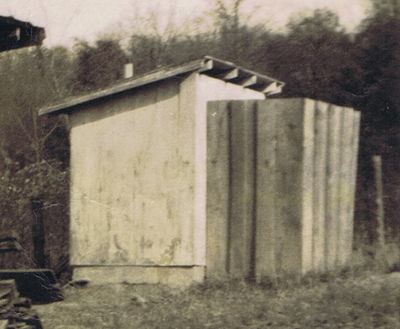
The following article by David Strange appeared in The Courier-Journal on 17 Aug 2014. It is archived here with additional information for your reading enjoyment.

Outhouse. Privy. Earth Closet. Little shack out back.
Perhaps you have visited them at one time or another.
As a young man, I traveled quite a bit with my Dad, visiting small churches around the state where he often preached. Back then, many of those little old country churches did not have plumbing. A few still don't. So, if a time came in which a person needed "facilities," the only option was to pay a visit to the little "outhouse" tucked over on the back of the property.
Now, I tell you, there is nothing that can make a city boy "hurry up" more than hearing the buzz of wasps flying around as he sits over a saw-cut opening in a rough wooden seat. The stories I had heard about everything from snakes to possums to spiders being down in that pit added to the urgency. With that in mind, it was standard practice on our travels to try to find a gas-station restroom somewhere before getting to the church, and hoping that "the need" would not rise again. It wasn't just churches, of course. My wife's grandmother had an outhouse at her home well into the 1970's, and I remember "holding it" for as long as possible when visiting there on Thanksgiving.
But looking back, there was a rustic charm to those old outhouses.
I remember birds singing as their feet tapped a dance on the sheet metal roof; occasional rain drops and falling acorns making their own drumbeat on that same roof; breezes gently blowing off the nearby cattle fields as the cows mooed their contented bass accompaniment off in the distance. I even remember listening to the elder men tell fascinating stories as they stood outside, chatting with one another, waiting their turn or just enjoying the fellowship and the day.
Despite the wasps, time had a way of slowing down out at the old outhouse. My nostalgia for them has been so strong that I once even wanted to make my indoor bathroom look like an outhouse, complete with sheet metal ceiling and wooden whitewashed walls with old license plates nailed to them. But my wife, Bonnie, would not let me.
There is more to an outhouse, by the way, than you might think.
According to National Public Radio's "Radio Lab," a good outhouse pit should be dug six feet deep. A study commissioned by John D. Rockefeller in 1908 found that many people were sickly and anemic because of parasites in the soil around where...well... "business was done." The study learned that many parasites, such as hookworms, can only travel a distance of about four feet. The simple idea of making an outhouse pit 6-feet deep thus made a real difference in health, especially in the warm South.
Randy Pace tells me that he doesn't remember a deep pit when he was a kid. He said that if it had ever been deep, it had long since filled up. Randy tells me of his mother's outhouse burning down one time. You see, they decided to burn the paper that had collected "down there." So someone struck a match, lit a piece of paper, and dropped it in.
This might be a good time for a quick lesson. You see, what is usually dropped in that pit creates methane gas as it decomposes. Methane, paper, and a match in a shallow hole are not a good combination inside a little wood building.
Odor from the methane could be a problem, as you might expect. Lynn Eddington remembers that many people would plant rose bushes around outhouses to help hide the smell. Lime would also be kept nearby, to sprinkle in the hole to neutralize the gas. The odor can also be reduced by installing a vertical vent pipe in the corner of the outhouse structure. In the warmth of the day the pipe is heated by the sun, which sets up a slow air convection current that draws fresh air into the privy hole, and expels the pit gases out the top of the vent.
Winter had its own set of issues with outhouses, as you might imagine. I am told that dressing for the weather with coat, etc. and trying to get to the outhouse and "prepare" before it was too late was sometimes a challenge of time. And then there was the sitting on ice cold boards to do your business. Savvy users would bring something warm with them to sit on.
Bob Cline remembers being in a hurry to get to the outhouse one cold winter day, and slipping and falling on the icy path. Suffice it to say that he no longer needed to go to the outhouse. Bob also remembers that store-bought toilet paper was seldom available in outhouses when he was a kid. On the farm they would use red and white corn cobs. Red one first; then a white one for finishing. The traditional paper, of course, was Sears & Roebuck Catalogues. They provided good reading, and a good use when done. Knowledgeable users knew to crumple the paper up first, to make it softer. Outhouse connoisseurs also knew to use the black and white pages, which were softer than the color ones.
Whether corn cobs or paper, it would often be stored in a tin can or glass jar to protect it from moisture and from mice.


Bob also remembers that it was a common childhood prank to lock a friend in the outhouse by latching it from the outside. Every boy knew to carry a pocket knife for just such occasions, slipping the blade through the crack in the door to slip the latch open.
I sometime wondered at outhouses that had lids over the holes, often actual store-bought toilet lids. But there is actually a good reason for them beyond decoration. Houseflies and other flying insects are attracted to the odor of decaying material, and mosquitoes will seek out standing water that may be present in the pit for the breeding of their offspring. So a tightfitting lid can reduce such infestations.
Of all the outhouses that I have been privileged to "visit," the most memorable to me was at one of the churches to which I traveled. The church attendance was fairly large, so they had a "four-holer" outhouse. You stepped in that white-walled outhouse, and there before you was one long box bench with four holes cut into it. No privacy partitions, mind you. Four holes, right there for communal use. One was even cut out small for children. That was indeed some outhouse. I remember being very pleased that there was no one else in line at the time to share the experience. I just did my business and got out of there as quick as I could, leaving the outhouse to the wasps and the wind.
There are still outhouses around, of course, at some homes and even at some churches. In some cases it is still out of need, because of the lack of running water and septic systems. Other churches and folks have resisted "going modern" with all the plumbing of new indoor restrooms. I have mostly ridiculed that thinking over the years, but I have come to more seriously consider the change. That plumbing did force a whole new set of worries on church leaders. Before "indoor outhouses" came to be, members would just fire up the wood stove when folks arrived on meeting day, with little thought of the building through the week. I remember very well that the preferred seating in such buildings was up close to that old pot-bellied stove. Today there is constant worry and maintenance to insure plumbing and other modern conveniences don't freeze or otherwise get damaged. I do believe that "modern" churches, with all their conveniences, have also caused people to worry more about the natural things than the spiritual.
But that is another story for another time. For now, I'm just glad to have the blessings of a modern restroom. The little outhouse of old is sure something to remember; but memory is a good place for it to be.
Copyright 2014 by David Strange, Shepherdsville KY. All rights are reserved. No part of the content of this page may be included in any format in any place without the written permission of the copyright holder.
The Bullitt County History Museum, a service of the Bullitt County Genealogical Society, is located in the county courthouse at 300 South Buckman Street (Highway 61) in Shepherdsville, Kentucky. The museum, along with its research room, is open 10 a.m. to 4 p.m. Monday through Friday. Saturday appointments are available by calling 502-921-0161 during our regular weekday hours. Admission is free. The museum, as part of the Bullitt County Genealogical Society, is a 501(c)3 tax exempt organization and is classified as a 509(a)2 public charity. Contributions and bequests are deductible under section 2055, 2106, or 2522 of the Internal Revenue Code. Page last modified: 12 Sep 2024 . Page URL: bullittcountyhistory.org/memories/outhouse.html